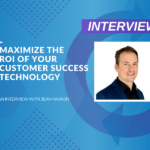Where Is Customer Success Headed In 2022?
After another unprecedented year (or two), Customer Success (CS) is forecasted for glass-shattering growth. With the increasing prominence of Net Dollar Retention (NDR) and the rise of CS Operations, the industry as we know it is transforming and evolving dramatically. Old paradigms have been accelerated by automation, advanced analytics, and digitization to set an entirely new standard for success for the industry. With all the changes, what will Customer Success look like in 2022 and beyond?
To uncover the cutting-edge trends that are shaping the future of Customer Success, Valuize’s Founder and CEO, Ross Fulton, spoke to Gainsight’s CEO and Customer Success expert, Nick Mehta. Through Gainsight, Nick has built and shaped the Customer Success industry into the recurring revenue powerhouse that’s taking over the SaaS business model worldwide. Nick has been named one of the Top SaaS CEOs by the Software Report three years in a row and has co-authored two books on Customer Success; Customer Success: How Innovative Companies Are Reducing Churn and Growing Recurring Revenue, and The Customer Success Economy: Why Every Aspect of Your Business Model Needs A Paradigm Shift.
In the interview, Nick evaluates the state of Customer Success today and offers his expert insight into the trends that Customer Success leaders should seize to grow and prosper in 2022 and beyond.
Q: 2021 was an exciting year for Customer Success. How would you summarize the last year and how do you think Customer Success as an industry, profession and domain has evolved over time?
A: In the early days of the industry, Customer Success teams were trying to justify their own existence and establish why they mattered. However, in the last couple of years, Customer Success has firmly secured its seat at the executive table. There’s now this badass energy in Customer Success; industry professionals have confidence and swagger. CS leaders are no longer trying to prove that they matter, they’re now focused on delivering, very similar to a Sales leader. No Sales leaders have to prove that they matter, but they do have to prove that they deliver every day and that’s what’s happening in Customer Success right now.
Q: In the last year or so, the understanding of how to measure the value of Customer Success as a strategic and operational model in a company has accelerated. Net Dollar Retention as a metric allows CS teams to have a tangible conversation around the benefit of investing in the domain and prove that they drive valuation and profitability for the business. Do you think the economic basis of Customer Success is firmly established in the industry or do you think there’s still work to be done in this area?
A: Net Dollar Retention is a major metric that investors care about. Over the years, public companies started reporting on NDR, which caught analysts’ attention. All of a sudden, analysts are now actively asking about it, CEOs are getting asked about it and they in turn are asking their management teams about it. In doing so, leaders realized that although part of your Net Dollar Retention is determined by your company’s DNA and the nature of your business, the way to truly optimize this metric is to look at end-to-end customer value realization through Customer Success. Ultimately, this experience gave CS leaders a clear and well-established identity; there’s a metric that I own that matters. Sales owns bookings and revenue, and Customer Success now owns Net Dollar Retention. This shift towards NDR also made the conversation with the CFO more straightforward and precise; today, CS leaders are trying to prove how their actions are driving NDR and the business impact to further investments in CS.
In terms of the economics of CS, the nuances we’re trying to decipher are facets like the impact of funding in CS, sizing a CS organization and investing in Customer Success Operations. These are the things that leaders are turning their attention to.
Q: The reality of an enterprise driving customer value realization & best-in-class Net Dollar Retention is a multi-functional motion that involves various teams across the organization. Do you think it’s risky for CS leaders to approach this as a single-functional role?
A: There’s a careful balance here, because CS leaders need to define and defend their ownership area but they also can’t exist on their own. The good news is, this is true across all performance bases; for instance, a Sales leader cannot be successful without a good product to sell and an effective Marketing team that generates marketing leads, but they also can’t shy away from their accountability to generate Sales. Sales leaders have long been empowered to own revenue and help identify what they need to actually hit their targets from Marketing, Product, Customer Success, etc., and the same thing needs to happen for Customer Success. As a CS leader, you must own the NDR and Gross Retention number and you also need to be clear about what you need from other cross-functional teams. You should convey the same level of confidence required to own the number, have a thorough understanding of the metrics required to articulate what’s happening, and establish the authority to ask people for help as needed. You need to be able to clearly articulate; this is what I did in my career, and the impact it had was tremendous. You’ve earned a seat at the table, but now you’ve got to show up like a performance-driven executive to secure the support you need from other teams to drive customer value realization.
Q: What do you see as the trajectory of Customer Success Operations? Do you think CS Operations is going to continue to blaze its own trail or do you see a consolidation happening?
A: If you asked me for the biggest trend in Customer Success right now, I’d say it’s CS Operations without hesitation. It’s all connected – you have earned a seat at the table and you’re now being asked to drive performance and customer value realization, show your impact and articulate the help you need from others. It’s irresponsible to do that without data and clear processes, and that’s exactly what CS Operations does. I’m not overstating this – you will not be successful if you don’t have an Operations team to help you understand the results you’re generating and their key drivers, and then put the right processes in place to improve and scale your operations.
Looking at today’s SaaS leaders investing in CS Operations, there are two valid and commonly used models you can consider to approach this function. The first approach is to assign a Director or VP of CS Operations under your Head of Customer Success. This person will be 100% focused on CS Operations – they have all the Post-Sales Operations underneath them, which may include Services, Support and CS as an integrated function. The second method is to consolidate all of your Revenue Operations functions, such as Marketing, Sales and Customer Success, under your COO or equivalent. If you have a product-lead growth model, it’s a little harder to separate Marketing, Sales and CS and they work best as an integrated Rev Ops function. If you have more of a classic enterprise model with a long sales cycle, then separating these functions and assigning CS Operations under the CCO works better.
Regardless of the approach you take, it’s critical that you have dedicated resources that are focused solely on CS Operations. If you’re interested in learning about best practices to build an industry-renowned CS Operations organization and maximize customer value realization, watch the first session of our new LinkedIn Live series, On CS Ops, A Conversation With Emily Ryan.
Q: The ongoing COVID-19 global pandemic has accelerated digital adoption guidance and digital Customer Success. Do you think B2B enterprises have crossed the chasm in regards to the ‘why’ of digital CS and are ready to tackle the ‘what’ and ‘how’?
A: I think the concept of digital has definitely crossed the ‘why’ chasm. I’d say there are three big reasons that come together to answer this ‘why.’ Firstly, B2B technology businesses are scaling like never before and, because of their digital-first business model, these organizations have a much more significant volume of customers. This creates an incredible scale challenge, which has only been exacerbated by COVID-19. The second big reason lies in the product-lead growth world in which companies are leveraging their product itself to boost sales. Lastly, the third and final reason is consumer behavior change. In the last few years, most consumers have rapidly and radically increased their own digital experience consumption through companies like Netflix, DoorDash, UberEATS, Airbnb and the like. This profound digitization in our personal lives has spilled into our professional lives and we’re all left asking: why can’t I just do this through an app and self service? The combination of these three headline factors – the rapid scaling of businesses, product-led growth, and shifting consumer expectations – is changing everything.
While businesses have figured out the ‘why’, they’re still trying to figure out the ‘how.’ Some organizations are sending email campaigns to all of their segments, some are initiating digital engagement with their smaller customers and trying to scale this across all of their customers, while others are trying to do digital directly within their product and leverage online communities. A lot of innovation is happening in digital CS, so it’s a very exciting time to get involved!
Q: Looking ahead, what are your recommendations for what CS leaders should focus on next as they plan for calendar year 2022?
A: Once your CS organization is enabled and empowered with a CS Operations team, the next step is to implement digital as a revenue-driving strategy. Many companies approach digital as a pyramid with high-touch and low-touch customers, but it’s critical to remember that digital is a strategy, not a segment. There are certain digital activities that you can do with your bigger customers, as well as your smaller customers, that will still keep them engaged, happy and drive customer value realization.
The second thing to keep in mind is that digital is not just about email. Everyone starts with email, but digital also needs to include your product. This can’t be a separate initiative between your Product and Customer Success teams; these teams need to come together to create a seamless experience and drive value realization for your customers. This concept is very much the frontier of Customer Success.
The third thing that CS leaders should consider is their approach to the customer journey. You may think you’re driving your customers through a journey to get them to adopt and renew; or, here’s another way to think about it – you’re driving value, which, in reality, is what actually drives renewal and expansion. Some companies have been talking about this for years, but I think people are just now starting to get serious about engineering value into their business processes. At Gainsight, we’re building a value framework that’s very much modeled around the concept of ValueXperience. You need a value realization framework for your company; this will serve as your way to consistently talk about value in an organized taxonomy from Pre-Sales to implementation of Post-Sales. Ultimately, this needs to be a cross-functional process with the goal of outlining the business processes that power your end-to-end value framework.
Q: Do you think it’s feasible and realistic that advanced and predictive analytics/ AI is going to break out in 2022? Or, do you think there’s still too much foundational data work to be done before that happens?
A: I’d say predictive analytics is an emerging trend in Customer Success, because many companies have a lot of foundational work to do before they can get there. Back in 2013 when we launched Gainsight, there were some companies that wanted to do AI and Customer Success, and we said we’re not ready for that. Instead, one of the things that we focused on was identifying and tracking processes, because AI needs to work off of some dataset.
One of the things that I think CS teams have done a good job of is establishing playbooks. Gainsight’s software does this, but that act itself is really foundational. With these established, you then need to pair your playbooks with your outcomes data related to renewals and adoption. If you’re tracking your activities and have some adoption and NPS data, then it’s absolutely achievable for companies to implement AI in their Customer Success motion; when done right, this will help you understand what kind of attributes and customers are correlated with higher adoption, higher NPS and, eventually, higher Net Dollar Retention.
Another thing that I think is achievable is optimizing the leading indicators that you’re looking for. AI should be able to help you automatically tweak your health score based on what things are actually driving renewals versus not and help you automate your health score algorithm. The last thing I’ll mention, that ties into all of this, is the likelihood of a given customer to renew or expand. With the right processes and data, AI should be able to help you decipher that.
Q: An emerging appetite in enterprises, and what I think is going to be a trend in 2022, is the ability to collaborate with the customer throughout the customer lifecycle. What are you seeing in this area that you’re excited about?
A: All of us have banged our head against the wall with a customer at some point because there’s only so much we can do as the vendor. That’s why it’s essential to set realistic expectations up front and clearly outline what the customer’s role is. The notion of a shared success plan, that’s defined in the Sales process and collaborated on cross-functionally and with the customer, is very important. I think there’s some good momentum here as organizations are starting to ask the question – how do we bring the customer into Customer Success? In some cases, you might extend that even further; how do we get a customer connected with other customers? At this point, you’re blurring the lines between the vendor, the customer, the community and the product because you need all of that, in unison, to drive success and customer value realization.
2022 Will Be A Big Year For Customer Success
Customer Success is growing at a rapid rate and 2022 is ripe for change. With AI, advanced analytics and deep customer collaboration on the horizon, you need to set your organization up for success now in order to take full advantage of these opportunities. By creating a powerful CS Operations organization, a robust digital strategy and a value-centric approach to success, you can ensure that your Customer Success organization will survive and thrive through the years and trends that lay ahead.
Listen to Nick’s full interview on the Customer Valuecast podcast for a deeper dive into the trends that are shaping Customer Success and how you can successfully meet the needs of the future and maximize customer value realization.






